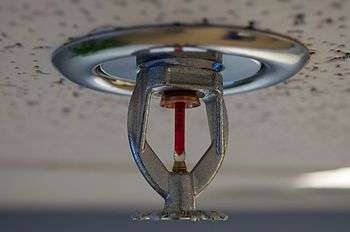Active fire protection


Active fire protection (AFP) is an integral part of fire protection. AFP is characterized by items and/or systems, which require a certain amount of motion and response in order to work, contrary to passive fire protection.
Categories of active fire protection
Fire suppression
Fire can be controlled or extinguished, either manually (firefighting) or automatically. Manual control includes the use of a fire extinguisher or a standpipe system. Automatic control means can include a fire sprinkler system, a gaseous clean agent, or firefighting foam system. Automatic suppression systems would usually be found in large commercial kitchens or other high-risk areas.
Sprinkler systems
Fire sprinkler systems are installed in all types of buildings, commercial and residential. They are usually located at ceiling level and are connected to a reliable water source, most commonly city water. A typical sprinkler system operates when heat at the site of a fire causes a glass component in the sprinkler head to fail, thereby releasing the water from the sprinkler head. This means that only the sprinkler head at the fire location operates – not all the sprinklers on a floor or in a building. Sprinkler systems help to reduce the growth of a fire, thereby increasing life safety and limiting structural damage.
Fire detection
Fire detection works using smoke or heat sensors. These systems are very effective tool at alerting people in the immediate vicinity of where the fire is detected but building regulations[1] require an integrated fire detection system. These system not only alerts people throughout the building by triggering the fire alarm but it can also summon emergency services. There are two types of systems available – addressable and conventional. Addressable systems monitor the specific location of each device (eg smoke detector, call point or sounder). It means in the event of a fire or other emergency you know exactly where the problem is. This saves precious time and helps the emergency services prevent the loss of life and serious damage. Conventional systems can only determine the problem is in a general area and thus are more suited for small sites.[2]
When the fire detection system is activated it can also send an alert to the local fire department, broadcast a prerecorded warning message and unlock the buildings access control system.
Hypoxic air fire prevention
Fire can be prevented by hypoxic air. Hypoxic air fire prevention systems, also known as oxygen reduction systems are new automatic fire prevention systems that reduce permanently the oxygen concentration inside the protected volumes so that ignition or fire spreading cannot occur. Unlike traditional fire suppression systems that usually extinguish fire after it is detected, hypoxic air is able to prevent fires. At lower altitudes hypoxic air is safe to breathe for healthy individuals.
Construction and maintenance
All AFP systems are required to be installed and maintained in accordance with strict guidelines in order to maintain compliance with the local building code and the fire code.
AFP works alongside modern architectural designs and construction materials and fire safety education to prevent, retard, and suppress structural fires.
See also
References
- ↑ "SANS10400 Building Regulations".
- ↑ "Fire Detection Systems". Intellisec.
External links
| Wikimedia Commons has media related to Firefighting. |
| Wikimedia Commons has media related to Fire protection. |
- Treatise on Active and Passive Fire Protection from UK Government
- When Fire Strikes, Stop, Drop and... Sing? – Article about acoustic fire suppression, Scientific American, January 24, 2008
- Karlsruhe Institute of Technology (KIT) - Forschungsstelle für Brandschutztechnik
.jpg)